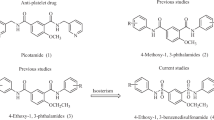Abstract
The ability of 5-nitro-, 7-nitro-, and 5,7-dinitrobenzotetrazine-1,3-dioxides to generate nitric oxide (NO) and activate soluble guanylate cyclase was investigated. All of these compounds were found to be thiol dependent NO-donors and guanylate cyclase activators. The maximal stimulatory effect of 5-nitro-, 7-nitro-, and 5,7-dinitrobenzotetrazine-1,3-dioxides was observed at 10 μM concentration and the activity increase was 4.5-, 15.0-, and 8.2-fold in the presence of 20 μM dithiothreitol and 11.3-, 31.6-, and 20.5-fold, respectively, in the presence of added glutathione (100 μM). The NO-dependent mechanism of benzotetrazine-1,3-dioxide nitroderivative-induced activation of soluble guanylate cyclase (in the presence of 100 μM glutathione) was confirmed by the inhibition (by 78%) of 7-nitrobenzotetrazine-1,3-dioxide (10 μM)-stimulated guanylate cyclase activity in the presence of the NO-scavenger-2-(4-carboxyphenyl)-4,4,5,5-tetramethylimidazoline-1-oxyl-3-oxide (Carboxy-PTIO, 50 μM) and by the inhibition with 1H-[1,2,4 ]oxadiazolo[4,3-a]quinoxalin-1-one (ODQ, 0.3 μM) of 5-nitro-, 7-nitro-, and 5,7-dinitrobenzotetrazine-1,3-dioxides (10 μM)-stimulated guanylate cyclase by 34, 69, and 39%, respectively. All compounds used inhibited ADP-induced aggregation of human platelets with IC 50 of 10.0, 1.3, and 2.0 μM for 5-nitro-, 7-nitro-, and 5,7-dinitrobenzotetrazine-1,3-dioxides, respectively. A clearly defined correlation was established between the ability of the compounds to generate NO, activate soluble guanylate cyclase, and inhibit platelet aggregation.
Similar content being viewed by others
REFERENCES
Kerwin, J. F., Jr., Lancaster, J. R., Jr., and Feldman, P. L. (1995) J. Med. Chem., 38, 4343-4362.
Palmer, R. M. J., Ashton, D. S., and Moncada, S. (1988) Nature, 333, 664-666.
Murad, F. (1994) Adv. Pharmacol., 26, 19-35.
Craven, P., and De-Rubertis, F. (1983) Biochim. Biophys. Acta, 745, 310-321.
Massberg, S., Sausbier, M., Klatt, P., Bauer, M., Pfeifer, A., Siess, W., Fassler, R., Ruth, P., Krombach, F., and Hoffmann, F. (1999) J. Exp. Med., 189, 1255-1264.
Waldmann, R., and Walter, U. (1989) Eur. J. Pharmacol., 159, 317-320.
Walter, U., Eigenthaler, M., Geiger, J., and Reinhard, M. (1993) Adv. Exp. Med. Biol., 344, 237-249.
El-Daher, S. S., Eigenthaler, M., Walter, U., Furuichi, T., Miyawaki, A., Mikoshiba, K., Kakkar, V. V., and Authi, K. S. (1996) Thromb. Haemost., 76, 1063-1071.
Bassenge, E., Fink, N., Skatchkov, M., and Fink, B. (1998) J. Clin. Invest., 102, 67-71.
Volodarsky, L. B., and Tikhonova, L. A. (1985) Khim. Geterotsikl. Soedin., No. 6, 748-752.
Kirilyuk, I. A., Utepbergenov, D. I., Mazhukin, D. G., Fechner, K., Mertsch, K., Khramtsov, V. V., Blasg, I. E., and Haseloff, R. F. (1998) J. Med. Chem., 41, 1027-1033.
Ryaposova, I. K., Grigoryev, N. B., and Severina, I. S. (1994) Biochemistry (Moscow), 59, 389-392.
Severina, I. S., Belushkina, N. N., and Grigoryev, N. B. (1994) Biochem. Mol. Biol. Int., 33, 957-967.
Kotz, A. Ya., Grafov, M. A., Khropov, Y. V., Betin, V. L., Belushkina, N. N., Bussygina, O. G., Yazykova, M. Y., Ovchinnikov, I. V., Kulikov, A. S., Makhova, N. N., Medvedeva, N. A., Bulargina, T. V., and Severina, I. S. (2000) Br. J. Pharmacol., 129, 1163-1177.
Zeman, E. M., Baker, M. A., Lemmon, M. J., Pearson, C. I., Adams, J. A., Brown, J. M., Lee, W. W., and Tracy, M. (1989) Int. J. Radiat. Oncol. Biol. Phys., 16, 977-981.
Churakov, A. M., Ioffe, S. L., and Tartakovsky, V. A. (1991) Mend. Commun., 101-103.
Kurbanov, I. S., Mordvinzev, P. I., Aliev, D. I., and Vanin, A. F. (1989) Vopr. Med. Khim., 35, 87-91.
Mikoyan, V. D., Kubrina, L. N., Serezhenkov, V. A., Stukan, R. A., and Vanin, A. F. (1997) Biochim. Biophys. Acta, 1336, 225-234.
Chirkov, Yu. Yu., Tyshchuk, I. A., Belushkina, N. N., and Severina, I. S. (1987) Biokhimiya, 52, 956-963.
Garbers, D. L., and Murad, F. (1979) Adv. Cycl. Nucl. Res., 10, 57-67.
Bradford, H. M. (1976) Analyt. Biochem., 72, 248-254.
Born, G. V. R. (1962) Nature, 194, 927-929.
Akaike, T., Yoshida, M., Miyamoto, Y., Sato, K., Kohno, M., Sasamoto, K., Miyzaki, K., Ueda, S., and Maeda, H. (1993) Biochemistry, 32, 827-832.
Garthwaite, J., Southam, E., Boulton, C. L., Schmidt, K., and Mayer, B. (1995) Mol. Pharmacol., 48, 184-198.
Zhao, Y., Brandish, P. E., Divalentin, M., Schelvis, J. P. M., Babcook, G. T., and Marletta, M. A. (2000) Biochemistry, 39, 10848-10854.
Moro, M. A., Rassel, R. J., Cellek, S., Lizasoain, I., Su, Y., Darley-Usmar, V. M., Radomski, M. W., and Moncada, S. (1996) Proc. Natl. Acad. Sci. USA, 93, 1480-1485.
Mellion, B. T., Ignarro, L. J., Ohlstein, E. H., Pontecorvo, E. G., Hyman, A. L., and Kadowitz, P. J. (1981) Blood, 57, 946-955.
Author information
Authors and Affiliations
Rights and permissions
About this article
Cite this article
Pyatakova, N.V., Khropov, Y.V., Churakov, A.M. et al. Derivatives of Benzotetrazine-1,3-dioxide Are New NO-donors, Activators of Soluble Guanylate Cyclase, and Inhibitors of Platelet Aggregation. Biochemistry (Moscow) 67, 329–334 (2002). https://doi.org/10.1023/A:1014836516982
Issue Date:
DOI: https://doi.org/10.1023/A:1014836516982



